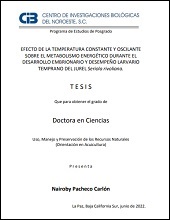Mostrar el registro sencillo del ítem
EFECTO DE LA TEMPERATURA CONSTANTE Y OSCILANTE SOBRE EL METABOLISMO ENERGÉTICO DURANTE EL DESARROLLO EMBRIONARIO Y DESEMPEÑO LARVARIO TEMPRANO DEL JUREL Seriola rivoliana
| dc.contributor.advisor | Racotta Dimitrov, Ilie Sava | |
| dc.contributor.advisor | Campos Ramos, Rafael | |
| dc.contributor.author | PACHECO CARLON, NAIROBY | |
| dc.date.issued | 2022 | |
| dc.identifier | https://cibnor.repositorioinstitucional.mx/jspui/handle/1001/2662 | |
| dc.identifier.uri | http://dspace.cibnor.mx:8080/handle/123456789/3127 | |
| dc.description.abstract | "La temperatura es el factor principal que influye en el proceso de desarrollo durante la ontogenia de los peces y tiene un efecto directo en la utilización y renovación de energía (ATP), en donde los embriones y larvas mantienen un balance energético celular (carga energética adenílica: CEA). Sin embargo, pocos estudios se han realizado comparando temperaturas constantes y fluctuantes de incubación, y se desconoce la respuesta energética durante los estadios de desarrollo tempranos. Seriola rivoliana es una especie emergente para la diversificación de la acuicultura marina en todo el mundo. Como objetivo general, se evaluó el efecto de la temperatura constante (20, 22, 24, 26, 28 y 30°C) y oscilante (entre 21 y 29°C) en el desarrollo y metabolismo energético de esta especie en el periodo de alimentación endógena. El rango viable de eclosión se obtuvo entre 20 y 28°C con una supervivencia mayor al 70%. Durante la embriogénesis, se observó un incremento gradual y significativo de ATP, en donde la CEA no fue influenciada por ningún régimen de temperatura y se mantuvo en niveles de alta viabilidad energética. Además, se observaron pocas variaciones en el contenido por individuo en proteínas, lípidos, carbohidratos, con excepto de los triacilglicéridos que fueron un combustible crítico durante la eclosión. Las larvas recién eclosionadas tuvieron una longitud total significativamente mayor a 22 y 24°C, y en la apertura de la boca entre 20 y 24°C, en donde se observó una mayor disponibilidad de lípidos provenientes de la gota de aceite. Los tratamientos oscilantes reflejaron lo observado a temperaturas constantes más altas (26 a 30°C), en donde no existió un patrón morfológico definido y fueron desove-específicos. Sin embargo, la oscilación inicial ascendente tuvo una mayor supervivencia larval a la apertura de boca en comparación a 28°C y a la oscilación inicial descendente. El crecimiento de la cabeza con respecto a la longitud total fue óptimo a 26°C y se observó una mayor incidencia y severidad del edema en vitelo a la apertura de boca entre 20 y 26°C, mientras que a 28°C y en los tratamientos oscilantes disminuyó. Lo anterior sugirió la elevación progresiva de la temperatura de 22-24°C después de la eclosión a 26°C. Se concluye que el jurel S. rivoliana tiene una gran plasticidad y capacidad de adaptación a la temperatura durante la embriogénesis y el desarrollo larvario temprano." | es |
| dc.format | es | |
| dc.language.iso | spa | es |
| dc.publisher | Centro de Investigaciones Biológicas del Noroeste, S.C. | es |
| dc.rights | Acceso abierto | es |
| dc.subject | Temperatura, Oscilación, Carga energética adenílica, Embriogénesis, Desarrollo | es |
| dc.subject | Temperature, Oscillation, Adenylate energy charge, Embryogenesis, Development | es |
| dc.subject.classification | EMBRIOLOGÍA ANIMAL | es |
| dc.title | EFECTO DE LA TEMPERATURA CONSTANTE Y OSCILANTE SOBRE EL METABOLISMO ENERGÉTICO DURANTE EL DESARROLLO EMBRIONARIO Y DESEMPEÑO LARVARIO TEMPRANO DEL JUREL Seriola rivoliana | es |
| dc.type | doctoralThesis | es |
| dc.dirtesis.grado | Doctorado en Ciencias en el Uso, Manejo y Preservación de los Recursos Naturales | es |
| dc.dirtesis.disciplina | Acuicultura | es |
| dc.dirtesis.universidad | Centro de Investigaciones Biológicas del Noroeste, S.C. | es |
| dc.dirtesis.facultad | Posgrado en Recursos Naturales | es |
| dc.description.abstracten | "Temperature is the main factor that influences the development process during fish ontogeny and has a direct effect on the use and renewal of energy (ATP), where embryos and larvae maintain a cellular energy balance (adenylate energy charge: AEC). However, few studies have been performed comparing constant and fluctuating incubation temperatures, and the energetic response during early developmental stages is unknown. Seriola rivoliana is an emerging species for the diversification of marine aquaculture throughout the world. As a general objective, the effect of constant temperature (20, 22, 24, 26, 28 and 30°C) and oscillating temperature (between 21 and 29°C) on the development and energy metabolism of this species was evaluated during the period of endogenous feeding. The viable hatching range was obtained between 20 and 28°C with a survival greater than 70%. During embryogenesis, a gradual and significant increase in ATP was observed, where AEC was not influenced by any temperature regime and remained at levels of high energetic viability. In addition, few variations were observed in the content per individual in proteins, lipids, carbohydrates, with the exception of triacylglicerides, which were a critical fuel during hatching. Newly hatched larvae had a significantly greater total length at 22 and 24°C, and at mouth opening between 20 and 24°C, where a greater availability of lipids from the oil drop was observed. The oscillating treatments reflected what was observed at constant higher temperatures (26 to 30°C), where there was no defined morphological pattern and they were spawning-specific. However, the initial upward oscillation had a higher larval survival at mouth opening compared to 28°C and the initial downward oscillation. Head growth with respect to total length was optimal at 26°C and a higher incidence and severity of yolk edema was observed at mouth opening between 20 and 26°C, while at 28°C and in oscillating treatments decreased. This suggested the progressive rise in temperature from 22-24°C after hatching to 26°C. It is concluded that the longfin yellowtail S. rivoliana has a great plasticity and adaptability to temperature during embryogenesis and the early larval development." | es |

